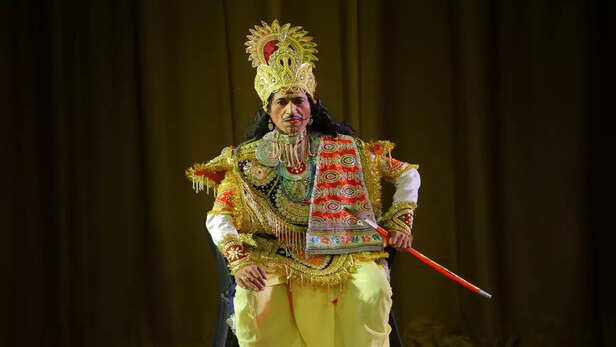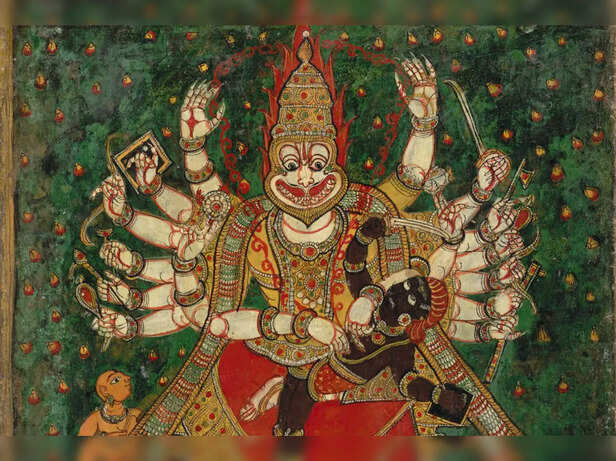Does Karma Really Come Back? Find the Answers Through these Stories
Shreya | Feb 02, 2025, 18:38 IST
( Image credit : Timeslife )
This article delves into the ancient concept of karma, as illustrated through Indian mythological stories. By examining tales from Hindu mythology, we uncover how actions, whether good or bad, lead to consequences in this life and beyond. Through these stories, readers can gain a deeper understanding of the principles of cosmic justice and how they have shaped the culture and beliefs of the Indian subcontinent.
Karma is a core belief of Hinduism, Buddhism, and Jainism and refers to the law of cause and effect—the idea that every action, whether good or bad, has consequences. In Indian history, karma is portrayed not just as a philosophical theory, but as a living force influencing the fate of gods, demons, and humans alike. This ancient concept transcends simple notions of reward and punishment, highlighting the intricacies of moral choices and their cosmic repercussions.
Indian mythological stories provide fascinating insights into karma’s workings. They depict how individuals’ actions, whether motivated by selfishness or selflessness, ultimately shape their destinies. Through these tales, we can gain a deeper understanding of karma and its role in maintaining balance in the universe. 
One of the most famous mythological stories demonstrating karma is the tale of King Harishchandra. Known for his unwavering commitment to truth and justice, King Harishchandra faced numerous hardships when he was tested by the sage Vishwamitra. Despite losing his kingdom, his family, and enduring severe trials, he remained dedicated to his moral integrity.
King Harishchandra’s devotion to truth, even under the harshest circumstances, is the embodiment of good karma. Ultimately, his sacrifices were rewarded when he was restored to his throne, and his story illustrates how the pursuit of truth and righteousness generates positive karmic consequences.
The essence of this tale lies in the belief that despite immediate suffering, adhering to moral principles leads to ultimate justice. The story of King Harishchandra emphasizes that karma works in divine ways, rewarding goodness with fulfillment and restoration.

In stark contrast, the story of Shakuni, the cunning uncle of the Kauravas in the Mahabharata, demonstrates how negative karma leads to destruction. Shakuni’s malicious actions of manipulating his nephews into waging war against the Pandavas stem from his desire for revenge and power. His deceitful tactics, including the game of dice that led to the Pandavas' exile, are driven by his negative karma, and ultimately, he faces dire consequences.
Shakuni’s life highlights how the pursuit of selfish desires and deceitful actions can lead to one’s downfall. His story shows the destructive nature of bad karma, showing that unethical actions cause suffering not just to others, but to the one who commits them as well.

On a more nuanced note, the story of Savitri and Satyavan also offers profound insights into the role of karma in shaping life and death. Savitri, a princess, marries Satyavan, a man whose life is marked by a tragic destiny as he is fated to die young. When the time arrives, the god of death, Yama, comes to claim Satyavan’s soul, but Savitri follows him, pleading for her husband's life.
Impressed by Savitri’s devotion, Yama allows her to return with her husband. The story emphasizes the role of good karma in the form of selfless love and devotion. Despite the inevitable nature of Satyavan's death due to his past karma, the devotion of Savitri shifts the course of fate, showing how actions motivated by love, devotion, and righteousness can have transformative, life-altering consequences.

Another compelling story demonstrating the power of good and bad karma is the tale of Prahlad and his father, Hiranyakashipu. Hiranyakashipu, a powerful demon king, desired to be worshipped as a god and became increasingly oppressive. His son, Prahlad, however, was a dedicated follower of Lord Vishnu, refusing to worship his father as a god.
Furious with his son’s defiance, Hiranyakashipu subjected Prahlad to numerous brutal attempts on his life, from being thrown into fire to being attacked by serpents. Yet, each time, Prahlad was miraculously saved by his devotion to Vishnu, embodying the powerful effect of good karma.
Hiranyakashipu’s negative karma, fueled by arrogance and evil actions, eventually led to his destruction. In the end, Lord Vishnu appeared in the form of Narasimha (half-man, half-lion) and tore Hiranyakashipu apart, demonstrating that no amount of cruelty could overcome divine justice. Prahlad's story underscores the profound impact of unwavering faith and devotion, showing that goodness is always protected by cosmic forces, while bad karma inevitably bring ruin.
Karma, as portrayed in these stories, is not merely a system of rewards and punishments; it is a cosmic balance, where every action creates ripples that extend beyond individual lifetimes. The gods and mortals in Indian history are all bound by karma's unyielding law, and each story serves as a reminder of how actions, whether performed in this life or past lives shape the future.
In Hinduism, it’s believed that karma does not necessarily lead to immediate punishment; instead, it often unfolds over multiple lifetimes, contributing to the cycle of samsara (reincarnation). The concept of karma teaches that every soul is accountable for its actions, which eventually determine the nature of its future existence. This moral dimension is central to understanding the universe’s structure and divine order.
Through stories like those of King Harishchandra, Shakuni, and Savitri, Indian history paints a vivid picture of how karma operates in the world. These tales are not just entertaining; they carry deep moral lessons about the importance of integrity, selflessness, and the consequences of our actions. The ancient concept of karma continues to inspire and shape the moral and spiritual fabric of Indian culture, reminding us that every action we take influences our future, both in this life and the next.
Indian mythological stories provide fascinating insights into karma’s workings. They depict how individuals’ actions, whether motivated by selfishness or selflessness, ultimately shape their destinies. Through these tales, we can gain a deeper understanding of karma and its role in maintaining balance in the universe.
The Story of King Harishchandra

Raja Harishchandra
( Image credit : Timeslife )
One of the most famous mythological stories demonstrating karma is the tale of King Harishchandra. Known for his unwavering commitment to truth and justice, King Harishchandra faced numerous hardships when he was tested by the sage Vishwamitra. Despite losing his kingdom, his family, and enduring severe trials, he remained dedicated to his moral integrity.
King Harishchandra’s devotion to truth, even under the harshest circumstances, is the embodiment of good karma. Ultimately, his sacrifices were rewarded when he was restored to his throne, and his story illustrates how the pursuit of truth and righteousness generates positive karmic consequences.
The essence of this tale lies in the belief that despite immediate suffering, adhering to moral principles leads to ultimate justice. The story of King Harishchandra emphasizes that karma works in divine ways, rewarding goodness with fulfillment and restoration.
The Story of Shakuni

Praneet Bhatt as Shakuni.
( Image credit : Timeslife )
In stark contrast, the story of Shakuni, the cunning uncle of the Kauravas in the Mahabharata, demonstrates how negative karma leads to destruction. Shakuni’s malicious actions of manipulating his nephews into waging war against the Pandavas stem from his desire for revenge and power. His deceitful tactics, including the game of dice that led to the Pandavas' exile, are driven by his negative karma, and ultimately, he faces dire consequences.
Shakuni’s life highlights how the pursuit of selfish desires and deceitful actions can lead to one’s downfall. His story shows the destructive nature of bad karma, showing that unethical actions cause suffering not just to others, but to the one who commits them as well.
The Story of Savitri and Satyavan

Satyavan Savitri Show
( Image credit : Timeslife )
On a more nuanced note, the story of Savitri and Satyavan also offers profound insights into the role of karma in shaping life and death. Savitri, a princess, marries Satyavan, a man whose life is marked by a tragic destiny as he is fated to die young. When the time arrives, the god of death, Yama, comes to claim Satyavan’s soul, but Savitri follows him, pleading for her husband's life.
Impressed by Savitri’s devotion, Yama allows her to return with her husband. The story emphasizes the role of good karma in the form of selfless love and devotion. Despite the inevitable nature of Satyavan's death due to his past karma, the devotion of Savitri shifts the course of fate, showing how actions motivated by love, devotion, and righteousness can have transformative, life-altering consequences.
The Story of Prahlad and Hiranyakashipu

Lord Narsimha and Hiranyakashipu.
( Image credit : Timeslife )
Another compelling story demonstrating the power of good and bad karma is the tale of Prahlad and his father, Hiranyakashipu. Hiranyakashipu, a powerful demon king, desired to be worshipped as a god and became increasingly oppressive. His son, Prahlad, however, was a dedicated follower of Lord Vishnu, refusing to worship his father as a god.
Furious with his son’s defiance, Hiranyakashipu subjected Prahlad to numerous brutal attempts on his life, from being thrown into fire to being attacked by serpents. Yet, each time, Prahlad was miraculously saved by his devotion to Vishnu, embodying the powerful effect of good karma.
Hiranyakashipu’s negative karma, fueled by arrogance and evil actions, eventually led to his destruction. In the end, Lord Vishnu appeared in the form of Narasimha (half-man, half-lion) and tore Hiranyakashipu apart, demonstrating that no amount of cruelty could overcome divine justice. Prahlad's story underscores the profound impact of unwavering faith and devotion, showing that goodness is always protected by cosmic forces, while bad karma inevitably bring ruin.
The Cosmic Balance of Karma
In Hinduism, it’s believed that karma does not necessarily lead to immediate punishment; instead, it often unfolds over multiple lifetimes, contributing to the cycle of samsara (reincarnation). The concept of karma teaches that every soul is accountable for its actions, which eventually determine the nature of its future existence. This moral dimension is central to understanding the universe’s structure and divine order.
Through stories like those of King Harishchandra, Shakuni, and Savitri, Indian history paints a vivid picture of how karma operates in the world. These tales are not just entertaining; they carry deep moral lessons about the importance of integrity, selflessness, and the consequences of our actions. The ancient concept of karma continues to inspire and shape the moral and spiritual fabric of Indian culture, reminding us that every action we take influences our future, both in this life and the next.
